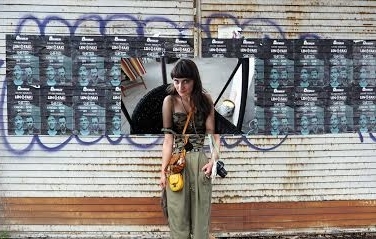Two Georgian Artists on Show at Original Artim Project in Baku
On April 12, the Artim Project Space in Baku announced the opening of the YARAT residency conclusive shows by Luke Burton (UK), Vajiko Chachkhiani (GEO), Gvantsa Jishkariani (GEO), Elturan Mammadov (AZ) and Zamir Suleymanov (AZ). This recently launched residency program aims to further support the local arts scene and encourage creative exchanges between local and international artists by inviting international artists to stay and work in Baku.
Each of the residents had been offered temporary working spaces at the YARAT Studios and support to develop works that will be presented at Artim as five solo shows.
Luke Burton’s ‘Crude Developments in Fountain Studies’ explores the way decoration is used within the urban environment to determine and shape a city’s identity, often from a received historical model of what constitutes a city. Vajiko Chachkhiani, with his ‘The Last Thing I Can Hold on to Are Your Kind Words,’ show presents a body of work that deals with the concepts of absence and presence. Gvantsa Jishkariani muses on the dominating mass-culture of Kitsch in her ‘Counterfeit Goods’ while Elturan Mammadov investigates Russian and Turkish influences over Azerbaijani vernacular culture in his ‘Shephard’s Dream’ and Zamir Suleymanov’s ‘Heavy Words’ deals with prevailing concerns and preoccupations of Azerbaijani society.
The Artim Project Space is directed at young Azerbaijani artists with an intention to support and encourage emergent talent to grow on the basis of the selection at the end of each year.
YARAT is an artist-founded, non-profit art organization based in Baku, Azerbaijan, established by Aida Mahmudova in 2011. YARAT (which means ‘create’ in Azerbaijani) is dedicated to contemporary art with a long-term commitment to creating a hub for artistic practice, research, thinking and education in the Caucasus, Central Asia and surrounding region. YARAT comprises the YARAT Art Center, Friends of YARAT Platform, ARTIM project space, YARAT Studios, Gallery and an extended educational program.
Education has been at the heart of YARAT’s activities since its creation. With a dedicated public program, including workshops, lectures, screenings and a specific program for artist residencies, YARAT aims to give access to broad audiences of all ages. The public program invests proactively in building communities and nurturing a wider understanding of, and participation in, contemporary art.
GEORGIA TODAY spoke with Gvantsa Jishkariani, one of the two Georgian participants: “I’m a 25 year-old independent artist, a member of Georgian Women Artists. I have a background in interior design. My way to visual arts was stipulated by studies in the informal master’s program at the Modern Art Center, which convinced me that art is one of the strongest tools to express one’s ideas. The time spent in Residency was really important as I had freedom, working materials and time that, in my opinion, I used well in the realization of many things. Here, the atmosphere is as different as the people and landscape are.” She says her greatest inspiration for this project came from artificial flowers, plants and animals, plantations in Baku, and shops. “It made me contemplate cultural identity. In Baku they have artificial flowers and it seems the illusion is there that they have something they do not actually have.”
“Gvantsa Jishkariani’s ‘Counterfeit goods’ is a title taken from the Simpsons animated sitcom that deals with everyday American life and its attitude towards a fake value system with subtle irony,” Elene Kapanadze, assistant-curator of Yarat, told us. “The artist sees this fixation with mass culture and a sarcastic take on it as very close to her own practice and so presents a body of work with similar ironic undertones. Maybe there is no moral. Maybe it’s just a bunch of stuff that happened to be made of polyethylene film laid on the floor with an enamel camel figurine that is incidentally a jewelry box. The polyethylene film creates a landscape that serves as a metaphor for the futuristic vision of a city. It is an allusively see-through, sterile, artificial and suffocating material, which seems to predict the future of a city with its parks set in stone. Nonetheless, as the title suggests, it might be just polyethylene with a camel.”
Another of Gvantsa’s works is reportedly a hill-out video installation in a niche, positioned so that, in order to view the video, one has to be very close to the screen. The video shows standard footage of nature that is supposedly used for relaxation. However, these videos are fast-forwarded and the viewer, placed too close to the screen, can hardly recognize what the running footage depicts. The installation offers a social commentary that suggests that it might be impossible to analyze situations and call things their names when put too close, when being part of them.
The show will run until May 1.
Maka Lomadze











